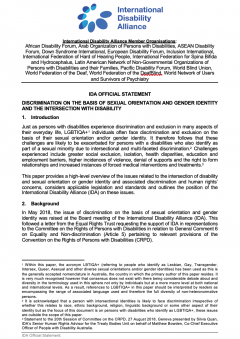Just as persons with disabilities experience discrimination and exclusion in many aspects of their everyday life, LGBTIQA+[1] individuals often face discrimination and exclusion on the basis of their sexual orientation and/or gender identity. It therefore follows that these challenges are likely to be exacerbated for persons with a disabilities who also identify as part of a sexual minority due to intersectional and multi-faceted discrimination. Challenges experienced include greater social exclusion, isolation, health disparities, education and employment barriers, higher incidences of violence, denial of supports and the right to form relationships and increased instances of forced medical interventions and treatments.
This paper provides a high-level overview of the issues related to the intersection of disability and sexual orientation or gender identity and associated discrimination and human rights’ concerns, considers applicable legislation and standards and outlines the position of the International Disability Alliance (IDA) on these issues.
